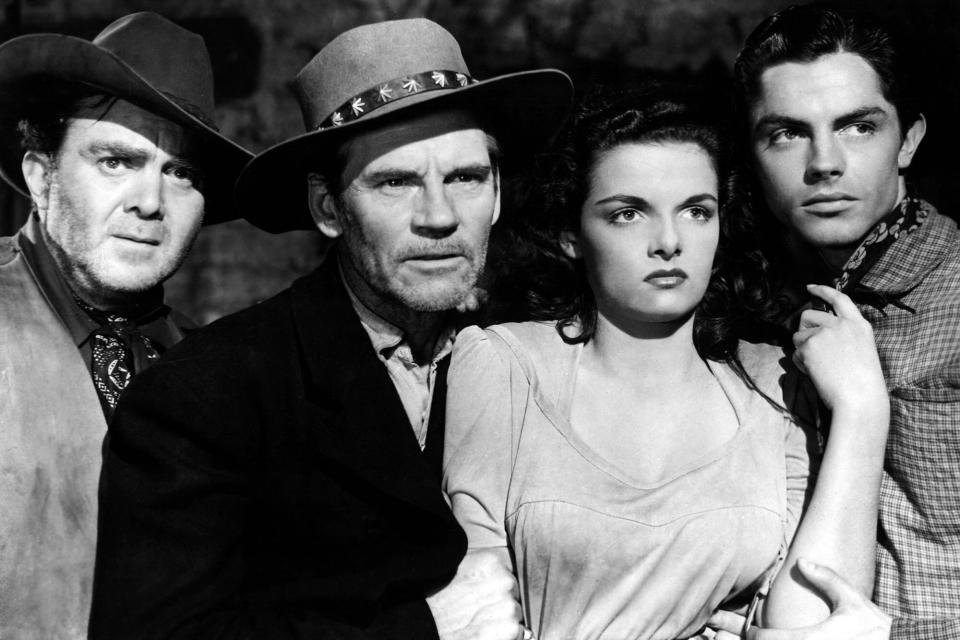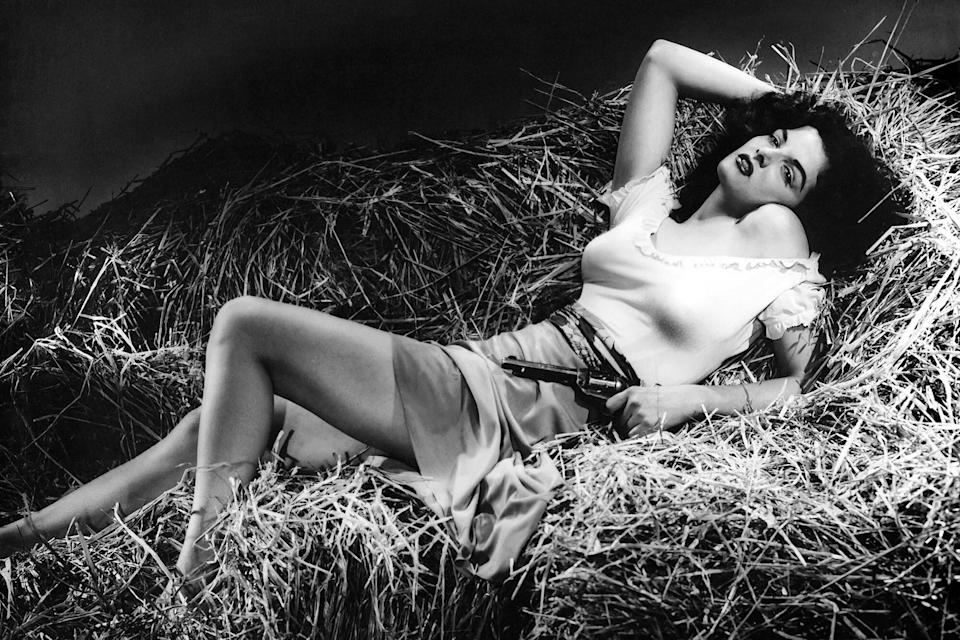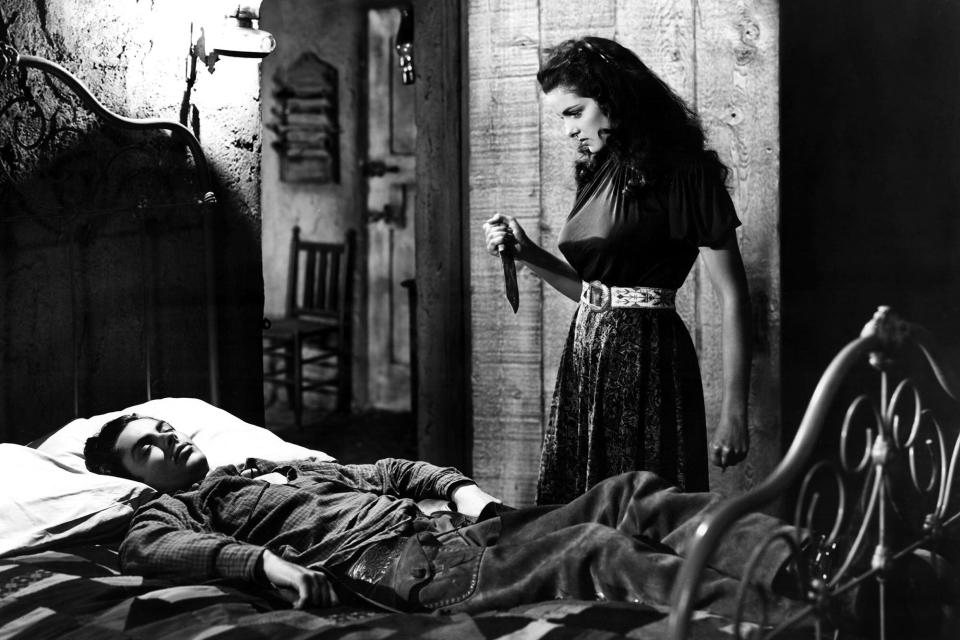The billionaire's bra brouhaha: How Jane Russell and an undergarment made The Outlaw a hit
- Oops!Something went wrong.Please try again later.
- Oops!Something went wrong.Please try again later.
- Oops!Something went wrong.Please try again later.
- Oops!Something went wrong.Please try again later.
When it comes to parsing man from myth, few prove more challenging than Howard Hughes.
The enigmatic aviator, inventor, and wannabe movie mogul yearned to be larger-than-life in everything he did, so it's no surprise that his legacy is rife with both hyperbolic tall tales and stranger-than-fiction truths. Take for example the story about the bra he designed for Jane Russell to wear in the 1943 Western The Outlaw.
A riff on Billy the Kid, the film represented one of Hughes' few directorial efforts. (He took over after alienating original helmer Howard Hawks.) But despite the many responsibilities that come with directing a feature film, Hughes became obsessed with — of all things — Russell's bust, and went so far as to design a custom brassiere for her.
Rumors paint the bra as a push-up prototype, drawing on Hughes' knowhow as an aerospace maverick. "Legend has made it sound like he was trying to design some kind of aerospace dynamic thing," Christina Rice, the author of Mean, Moody, Magnificent: Jane Russell and the Marketing of a Hollywood Legend, tells EW. "But according to Jane, he just wanted to do something that was seamless, so that under her clothes it didn't look like she was wearing a bra."

Everett Collection Thomas Mitchell, Walter Huston, Jane Russell, and Jack Buetel in 'The Outlaw'
Russell did, in fact, wear a bra in the film, but not Hughes' design. Declaring it "ridiculous," she threw Hughes' garment across her trailer and padded her own bra with tissues, creating the same seamless effect his flimsy invention intended. Hughes was none the wiser, and Russell's assets brought the film under scrutiny from the Production Code Administration, citing that "the girl's breasts are shockingly emphasized."
Joseph Breen, the head of the PCA, drew up a laundry list of breast shots and requested that Hughes make edits, which the tycoon fought against but ultimately relented to. While the edited film received a stamp of approval relatively swiftly, Hughes sought to use such censorship complaints to sell the film, understanding that building a campaign around Russell and objections to her assets would only drum up more interest. (Whether Hughes himself understood the film could never live up to its publicity remains unclear.)

Everett Collection Jack Buetel and Jane Russell in 'The Outlaw'
Few men understood the axiom "sex sells" better than Hughes, after all. For Breen's part, he was so aggravated by Hughes' insistence that censorship was holding up the film, and not Hughes' own machinations, that he wrote a letter to the editor of Look magazine attempting to set the record straight. "It's partly truth and partly exaggeration," Rice says, "and all Howard Hughes."
Russell was roped into the prolonged release scheme as well. Though The Outlaw wrapped filming in early 1941, the actress spent nearly two years doing constant publicity for it. "She said having her photo taken was practically a full-time job," Rice notes. Russell spent so long doing press for the film, which marked her screen debut, that she was dubbed the "motionless picture actress."

Everett Collection Jane Russell in a promotional photo for 'The Outlaw'
With the assistance of publicist Russell Birdwell — who famously engineered Gone With the Wind's "search for Scarlett" — and some infamously alluring "haystack" photos, Hughes capitalized on the moral outcry over Russell's bustline, resulting in a decade of sensational headlines, censorship, bans, and fractured release dates.
The haystack photos were another product of Hughes' manipulation. Shot by famed Hollywood photographer George Hurrell, the images were made much more provocative when Hughes ordered them edited to make Russell's blouse appear ripped and her skirt hiked up. Once again they produced a seamless effect, making Russell appear braless, with gravity-defying assets. (The cheesecake shots also helped make Russell a favorite pinup among American GIs in World War II.)
Russell was frustrated with Hughes using her in this way. "The haystack images she was okay with until they were doctored," Rice says. "She rolled into San Francisco for the premiere and started seeing these gigantic billboards of herself. She was mortified and really upset. And then her mom and aunt roll into town and see them, and her aunt actually went to Howard Hughes to give him a piece of her mind."

Everett Collection Jane Russell in a promotional photo for 'The Outlaw'
Ahead of that 1943 San Francisco premiere, there were demands across the city to take down the titillating billboards. The Motion Picture Council of San Francisco wrote to the PCA objecting to the billboards and their "very disgusting portrayal of the feminine star," and Hughes was threatened with arrest if he refused to pull them.
The film finally reopened in 1946, this time with a nationwide run in mind. It was quickly denied a certificate of approval by the MPAA and met with protests and bans across the country, but that didn't stop distributor United Artists from plowing ahead with an elaborate promotional tour. Everywhere The Outlaw went, it generated more outrage — and more interest. A Maryland judge famously upheld an exhibition ban in court, saying that Russell's breasts "hung like a thunderstorm over a summer landscape."

Everett Collection Jane Russell and Jack Buetel in 'The Outlaw'
As one might imagine, this all worked in the film's favor, leading it to break box office records wherever it played. Hughes trotted the picture out again in October 1949 once he was head of RKO, though by that time it had been approved by the PCA and the Legion of Decency, removing some of the intrigue associated with it. By the time all was said and done, The Outlaw had done major numbers at the box office, with a June 1968 edition of The Hollywood Reporter stating it had made more than $20 million.
As Rice says, "Birdwell took the insanity of Howard Hughes, the allure of Jane Russell, and turned it into this marketing campaign we're still talking about" — thereby transforming a mediocre Western oddity into something with bra'd appeal.
Order a copy of EW's final print edition now, or find it on newsstands beginning March 18.
Related content:

